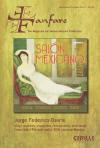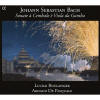Texte paru dans: / Appeared in:

Fanfare Magazine:
Pour
s'abonner / Subscription information
Les abonnés à Fanfare Magazine ont accès aux archives du
magazine sur internet.
Subscribers to Fanfare Magazine have access to the archives of the magazine
on the net.
Alpha 161

3760014191619
Consultez toutes les évaluations recensées pour ce cd
~~~~ Reach all the evaluations located for this CD
Bach wrote only three sonatas we know of for viola da gamba and harpsichord. Two of them—one in G Major, the other in D Major—conform to the four-movement sonata da chiesa layout, slow-fast-slow-fast. The third sonata, in G Minor, is the odd man out for being in only three movements, fast-slow-fast. Its first-movement Vivace is of such infectious enchantment and amusement that I would use it to introduce Bach to someone who thought his music was dry and boring. Dating of the three works is uncertain, though sometime between 1717 and 1723 during Bach’s Cöthen period seems a likely prospect. Almost certainly, however, the three sonatas were not composed together as a set; for their sequential numbering we can thank the BWV catalog, which simply groups works by categories regardless of when they were written.
The Sonata in D Minor, here transcribed from its original source, the Sonata in E Minor for Violin and Continuo, BWV 1023, is one of three such miscellaneous works, the others being the Sonatas in G Major, BWV 1021, and C Minor, BWV 1024. These do not belong to and are different in manner from the more widely known and frequently recorded six sonatas for violin and harpsichord, BWV 1014–19. These latter works, though sometimes performed with a cello or gamba reinforcing the keyboard’s bass line, are true duo sonatas, or what are sometimes referred to as “obbligato” sonatas, meaning that the keyboard parts are fully written-out and that the violin engages contrapuntally with the harpsichord as an equal partner.
BWV 1023 heard here is something different. The solo string instrument part is quite florid and almost improvisational sounding. The style seems to hark back to the violin sonatas of Biber. Very few changes have been made to the keyboard part in this transcription, other than transposing it down a step from E to D, but the viola da gamba part is transposed downward by a major ninth. This works fine in the performance heard here for just the two instruments, but it would certainly obviate the use of another gamba or low bass continuo instrument to reinforce the keyboard’s bass line.
Filling out the disc is Bach’s C-Minor Toccata, BWV 911, one of the seven solo harpsichord toccatas, BWV 910–16, likely written during his Weimar period, 1708–17.
The three gamba sonatas have long been played—and quite effectively, I might add—on modern violas and cellos, so it was with more than a little amusement that I found myself wondering, “How many strings does it take to play these pieces?” According to gambist Lucile Boulanger, the answer is seven. She informs us that since the D-Major Sonata requires a low A—I assume she means the A two octaves and a third below middle C—she has opted for a 2006 copy of a 1699 Joachim Tielke seven-string basse de viole by Belgian maker François Bodart.
Curiosity led me to do a little research on this behemoth. At 71 cm—nearly 30 inches in length—it would definitely have to be played cello-style, held between the knees. The more common six-string bass viol was tuned, from bottom to top, in fourths with a major third in the middle: D-G-C-E-A-D. The seven-string jumbo model Boulanger plays adds another fourth below the bottom D, the A to which she refers: A-D-G-C-E-A-D.
It turns out that the practice of using an extended seven-string bass viol is not so unusual after all. My longtime favorite gamba version of these sonatas has been Avie’s recording with gambist Jonathan Manson and harpsichordist Trevor Pinnock. For that recording Manson also uses a modern seven-string instrument by Massachusetts maker Curtis Bryant.
Boulanger and de Pasquale’s program is more varied and more generous, offering not only a violin sonata transcribed for gamba but one of the solo harpsichord toccatas. Manson and Pinnock also offer a transcribed sonata, the Flute Sonata, BWV 1030, which, in turn, is likely a transcription of a work originally written for oboe.
Generosity of program, of course, is not necessarily a reason to favor one recording over another, and in any case, some may consider the inclusion of a solo keyboard toccata in this context to be a musical non sequitur. What counts are the performances and the sound of the instruments, and here is where I must remain faithful to my preference for Manson and Pinnock. For one thing, in only one movement out of 11, the Andante of the D-Major Sonata, BWV 1027, are Manson and Pinnock slower than Boulanger and de Pasquale, and then only by four seconds. In every other movement, Boulanger and de Pasquale are quite a bit slower, in one case, the Andante to BWV 1028, by more than 30 seconds in a movement just longer than four minutes. Aside from the question this might raise concerning Boulanger’s nimbleness on her instrument, it results in readings that sag in the slow movements and lack liveliness in the fast ones.
But what bothers me even more is the sound of de Pasquale’s 1979 Philippe Humeau harpsichord after an 18th-century model attributed to Jean Henry Silbermann. It sounds twangy, washed-out, and flat, and not in the tuning sense. Its deficits become even more noticeable in the solo C-Minor Toccata, which has enjoyed countless recordings, usually in situ with its six siblings. Pinnock’s 1982 harpsichord by David Way modeled on an instrument by Jean Henri Hemsch is everything de Pasquale’s is not—full-bodied, bright-toned, and alive. In every respect, Manson and Pinnock win this contest hands down.
Cliquez l'un ou l'autre
bouton pour découvrir bien d'autres critiques de CD
Click either button for many other reviews


